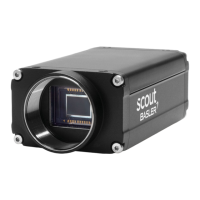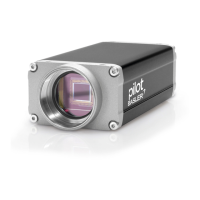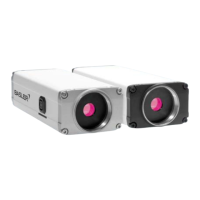AW00089317000 Image Acquisition Control
Basler ace GigE 163
Use Case 4 - Acquisition Start and Frame Start Triggers Both On
Use case four is illustrated on page 164.
In this use case, the Acquisition Mode parameter is set to continuous. The Trigger Mode parameter
for the acquisition start trigger is set to on and the Trigger Mode parameter for the frame start trigger
is set to on.
Because the acquisition start trigger mode is set to on, the user must apply an acquisition start
trigger signal to the camera. In this case, we have set the acquisition start trigger signal source to
software, so the execution of an acquisition trigger software command will serve as the acquisition
start trigger signal. The Acquisition Frame Count parameter is set to 3.
When an acquisition trigger software command is executed, the camera will exit the "waiting for
acquisition start trigger" acquisition status and enter a "waiting for frame start trigger" acquisition
status. Once the camera has acquired 3 frames, it will re-enter the "waiting for acquisition start
trigger" acquisition status. Before any more frames can be acquired, a new acquisition trigger
software command must be executed to make the camera exit the "waiting for acquisition start
trigger" acquisition status.
Because the frame start trigger is set to on, the user must apply a frame start trigger signal to the
camera in order to begin each frame acquisition. In this case, we have set the frame start trigger
signal source to input line 1 and the activation to rising edge, so the rising edge of an externally
generated electrical signal applied to input line 1 will serve as the frame start trigger signal. Keep in
mind that the camera will only react to a frame start trigger signal when it is in a "waiting for frame
start trigger" acquisition status.
A possible use for this type of setup is a conveyor system that moves objects past an inspection
camera. Assume that the system operators want to acquire images of 3 specific areas on each
object, that the conveyor speed varies, and that they do not want to acquire images when there is
no object in front of the camera. A sensing device on the conveyor could be used in conjunction
with a PC to determine when an object is starting to pass the camera. When an object is starting to
pass, the PC will execute an acquisition start trigger software command, causing the camera to exit
the "waiting for acquisition start trigger" acquisition status and enter a "waiting for frame start trigger"
acquisition status.
An electrical device attached to the conveyor could be used to generate frame start trigger signals
and to apply them to input line 1 on the camera. Assuming that this electrical device was based on
a position encoder, it could account for the speed changes in the conveyor and ensure that frame
trigger signals are generated and applied when specific areas of the object are in front of the
camera. Once 3 frame start trigger signals have been received by the camera, the number of
frames acquired would be equal to the setting for the Acquisition Frame Count parameter, and the
camera would return to the "waiting for acquisition start trigger" acquisition status. Any frame start
trigger signals generated at that point would be ignored.
This sort of setup is useful because it will only acquire frames when there is an object in front of the
camera and it will ensure that the desired areas on the object are imaged. (Transmitting images of
the "space" between the objects would be a waste of bandwidth and processing them would be a
waste of processor resources.)

